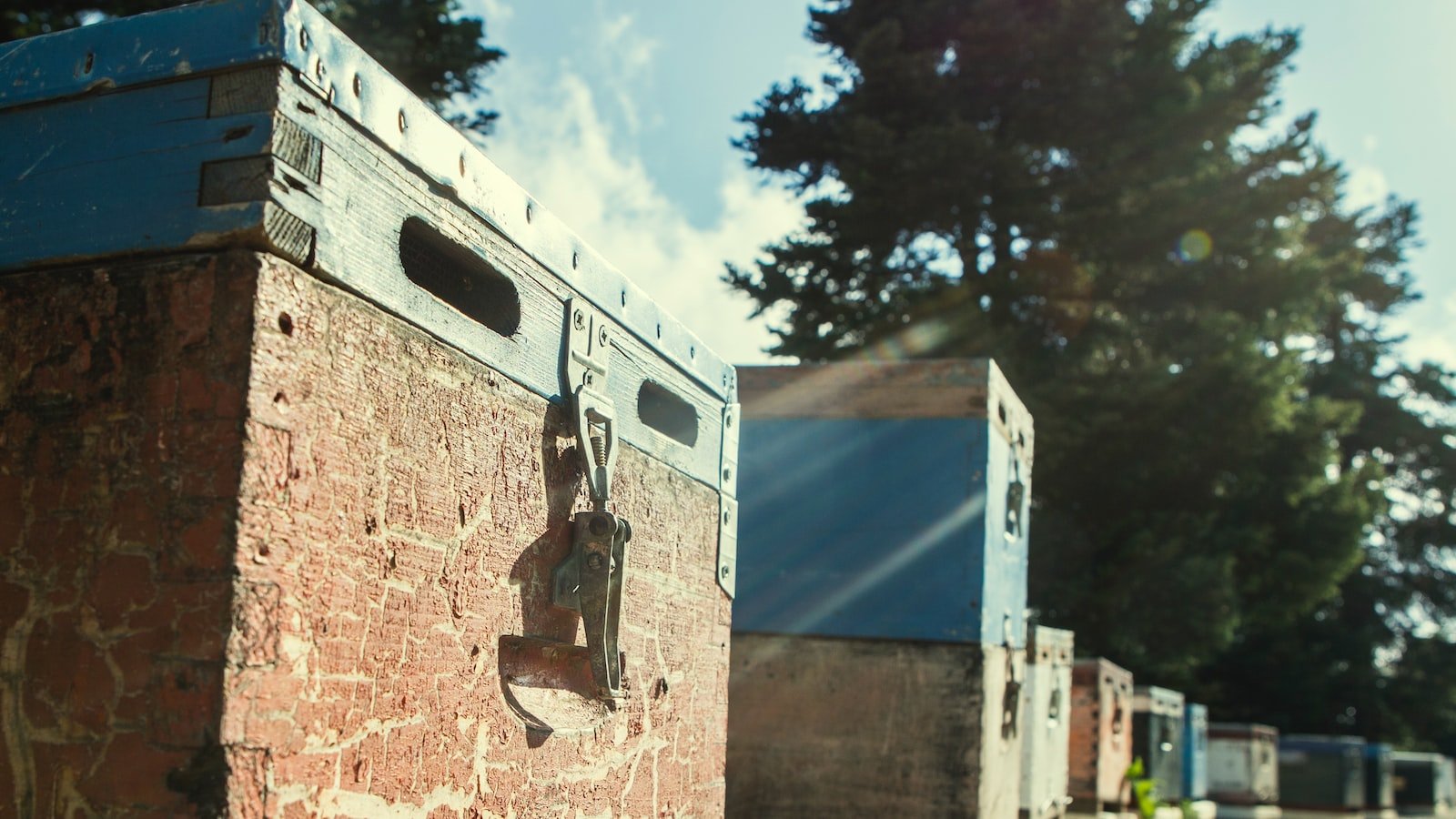Designing the perfect hive for our busy little pollinators is no easy feat. As beekeepers, we find ourselves faced with an inexhaustible array of hive designs, each promising to be more efficient, more sustainable, or more conducive to honey production than the last. But with such a bewildering variety to choose from, how can we determine which hive design is truly the bee’s knees? In this article, we embark on a journey through the pros and cons of different hive designs, examining their strengths and weaknesses, and discovering which honeybee homes might just make our buzzing friends a little happier. So, don your veil, grab your smoker, and let’s dive deep into the fascinating world of honeybee habitats!
Table of Contents
- The Pros and Cons of Different Hive Designs:
- – Traditional Langstroth Hive: A Classic Choice for Beekeepers
- – The Top Bar Hive: An Alternative Approach with Benefits and Limitations
- – Flow Hive: A Modern Revolution or a Gimmick?
- – Warre Hive: Embracing Natural Beekeeping with its Unique Advantages
- – Observation Hive: A Window Into the World of Bees
- Q&A
- Closing Remarks

The Pros and Cons of Different Hive Designs:
When it comes to beekeeping, choosing the right hive design is crucial for the success of your colony. Different hive designs offer unique advantages and disadvantages, catering to various beekeepers’ preferences and the needs of the bees themselves.
Top Bar Hive:
Pros:
- Cost-effective and easy to build: This simple design requires minimal materials and tools.
- Ability to observe bees easily: The top bar design allows for hassle-free inspections and observation.
- Less heavy lifting: Manipulating bars individually eliminates the need for lifting heavy supers.
Cons:
- Less honey production: Top bar hives typically yield less honey compared to other designs.
- Temperature control: Maintaining consistent warmth in colder climates can be more challenging.
- Limited expansion: Bees have less space to build comb, which may lead to potential overcrowding.
Langstroth Hive:
Pros:
- Maximum honey production: This design allows bees to store more honey due to its expandable nature.
- Easy management: Standardized frame sizes and modular construction simplify hive manipulation.
- Easier queen excluder usage: Perfect for selective brood rearing and honey harvesting.
Cons:
- Higher costs: Langstroth hives often involve more financial investment.
- Heavy lifting: Larger supers can be cumbersome, especially for people with physical limitations.
- Complex inspections: Removing multiple frames may disturb bees during inspections.

– Traditional Langstroth Hive: A Classic Choice for Beekeepers
The traditional Langstroth hive has stood the test of time as a classic and reliable choice for beekeepers. Developed in the mid-19th century by beekeeper Lorenzo Lorraine Langstroth, this hive design revolutionized beekeeping practices and remains widely used today.
One of the key features of the Langstroth hive is its modular design, consisting of stacked wooden boxes, commonly known as supers, which house the bees and their honeycombs. These supers are designed to accommodate standardized wooden or plastic frames, allowing for easy inspection and management of the hive.
Another advantage of the Langstroth hive is its versatility. Beekeepers can add or remove supers as needed, providing flexibility during honey extraction or other hive management tasks. This adaptability makes the Langstroth hive suitable for both professional beekeepers and hobbyists alike.
In addition to its practicality, the Langstroth hive promotes optimal bee health and honey production. The design incorporates a movable frame system, which enables beekeepers to inspect individual frames without disturbing the entire hive. This not only allows for early detection and management of diseases or pests but also minimizes the stress on the bees.
Overall, the traditional Langstroth hive’s enduring appeal lies in its practicality, versatility, and promotion of healthy bee colonies. Whether you are an experienced beekeeper or just starting your beekeeping journey, the Langstroth hive is a reliable choice that stands as a testament to the legacy of Lorenzo Lorraine Langstroth.
– The Top Bar Hive: An Alternative Approach with Benefits and Limitations
The top bar hive is a unique and alternative approach to beekeeping that offers a range of benefits and limitations. Unlike traditional Langstroth hives, which use framed boxes, the top bar hive is a horizontal design that promotes natural bee behavior and minimal interference.
Benefits of the top bar hive include:
- Cost-effective: Constructing a top bar hive is relatively inexpensive compared to purchasing Langstroth equipment.
- Accessibility: The horizontal design of the top bar hive makes it easier for beekeepers to access and inspect individual combs.
- Less intrusive: With top bar hives, beekeepers do not need to remove and disrupt entire frames, allowing bees to maintain their natural comb-building instincts.
- Varroa mite control: The open broodnest of a top bar hive can positively affect varroa mite management, making it an attractive option for those seeking alternative ways to control these pests.
Limitations of the top bar hive include:
- Lower honey yields: Due to the horizontal design and lack of standardized frames, top bar hives typically produce lower honey yields compared to Langstroth hives.
- Frequent inspections: Beekeepers using top bar hives need to inspect and manage their hives more frequently to prevent crosscomb, ensure proper comb alignment, and monitor colony health.
- Mobility: Top bar hives can be challenging to move due to their size and construction. They may not be suitable for beekeepers who frequently need to transport their hives.
Choosing the right hive design will ultimately depend on individual preferences, beekeeping goals, and management practices. The top bar hive offers a fascinating alternative with its unique advantages and considerations, making it an appealing choice for those looking to explore a different approach to beekeeping.
– Flow Hive: A Modern Revolution or a Gimmick?
Flow Hive: A Modern Revolution or a Gimmick?
When it comes to beekeeping, the introduction of the Flow Hive sparked spirited debates among enthusiasts and experts alike. Some hail it as a modern revolution, while others view it as nothing more than a gimmick. Let’s delve into the key aspects of this innovative invention to better understand its implications.
Advocates of the Flow Hive applaud its user-friendly design and claim that it has revolutionized the beekeeping industry. With its unique extraction system, honey can be harvested from the hive without disturbing the bees or the comb. This means less stress for the bees and less work for the beekeepers. The Flow Hive’s technological advancements simplify the extraction process, allowing even beginners to tackle beekeeping with confidence.
However, critics argue that the Flow Hive oversimplifies a complex and delicate process. They claim that while it may save time and effort on the surface, it lacks the hands-on interaction and understanding required to truly connect with the bees and their environment. Additionally, the initial setup cost of a Flow Hive can be considerably higher than traditional beekeeping equipment, making it less accessible to those on a budget.
Ultimately, whether the Flow Hive is a modern revolution or a gimmick depends on one’s perspective and goals as a beekeeper. It offers convenience and innovation for some, but may not align with the principles of others who prioritize a deeper connection with nature.
- Warre Hive: Embracing Natural Beekeeping with its Unique Advantages
When it comes to beekeeping, the Warre Hive stands out as a remarkable choice for enthusiasts looking to embrace natural beekeeping practices. This unique hive design offers several advantages that set it apart from conventional methods.
One key advantage of the Warre Hive is its emphasis on mimicking the bees’ natural habitat. With its square-shaped boxes and top bars, this hive allows bees to build their comb freely and promotes natural cell sizes. By providing an environment that closely resembles the bees’ wild nesting preferences, the Warre Hive encourages healthier and more contented colonies.
Additionally, the Warre Hive requires minimal intervention from beekeepers, as it favors a hands-off approach. Regular inspections are limited, reducing the stress on both the bees and the beekeeper. This approach aligns with the principles of sustainable beekeeping, promoting the bees’ natural resilience and self-sufficiency.
Advantages of the Warre Hive:
- Natural Comb Building: The square-shaped boxes and top bars allow bees to build their comb freely, mimicking their natural habitat and promoting healthier colonies.
- Minimal Intervention: Unlike other hive designs, the Warre Hive requires fewer inspections and interventions, reducing stress on the bees and beekeepers alike.
- Sustainable and Resilient: By embracing natural beekeeping methods, the Warre Hive promotes the bees’ self-sufficiency and overall hive resilience.
For beekeepers interested in a more hands-off and eco-friendly approach, the Warre Hive offers a compelling option. Its unique advantages work harmoniously to create a hive system that aligns with the bees’ natural instincts, creating a healthier and more sustainable beekeeping experience.
– Observation Hive: A Window Into the World of Bees
Observation Hive: A Window Into the World of Bees
Step into the fascinating world of bees with an observation hive—a captivating and educational window that allows us to peek into the intricate lives of these incredible creatures. The observation hive is a transparent enclosure that provides an up-close and personal look at the daily activities of a bee colony. It serves as a miniature replica of a beehive, giving us a glimpse into the complex social organization, hive maintenance, and honey production that takes place within.
With its carefully designed structure, the observation hive offers several unique advantages. Firstly, it allows us to observe the bees without disrupting their natural behavior. This non-invasive approach ensures that the hive remains undisturbed, allowing the bees to go about their daily tasks without unnecessary stress. Secondly, the transparent walls of the observation hive offer an unobstructed view of the bees’ activities, making it easier for researchers, beekeepers, and enthusiasts alike to study and appreciate their behavior.
- Watch as worker bees diligently gather nectar and pollen, carefully tend to the queen, and construct intricate honeycombs.
- Marvel at the mesmerizing waggle dance, a unique form of communication employed by bees to communicate the location of food sources.
- Witness the collective efforts of the colony as bees tirelessly fan their wings to regulate temperature and ensure optimal hive conditions.
The observation hive serves as a powerful tool for education, captivating both young and old with its mesmerizing view into the enchanting world of bees. Whether you’re an aspiring beekeeper, a curious student, or simply someone fascinated by the wonders of nature, this window into the bee kingdom is sure to leave you with a newfound appreciation for these remarkable creatures.
Q&A
What are the advantages of a Langstroth hive design?
Langstroth hives allow easy inspection and management of bee colonies, thanks to their removable frames. They also promote efficient honey production and extraction, making them a popular choice for beekeepers.
What are the drawbacks of a Langstroth hive design?
One downside is the potential for heavy lifting, as Langstroth hives can become heavy when filled with honeycomb and honey. Another drawback is the increased risk of spreading diseases among colonies due to their close proximity.
What are the benefits of a Warre hive design?
Warre hives are known for their simplicity and low maintenance requirements. They closely mimic the natural habitat of bees and promote a more natural beekeeping approach. The compact size of Warre hives also makes them suitable for urban beekeeping.
What are the disadvantages of a Warre hive design?
Warre hives lack the frame-and-foundation system found in Langstroth hives, which can make inspections and bee management more challenging. Additionally, honey extraction from Warre hives can be more labor-intensive compared to other hive designs.
What are the advantages of a Top-Bar hive design?
Top-bar hives offer simplicity and cost-effectiveness, making them an attractive option for beginner beekeepers or those on a tight budget. They allow for natural comb building, providing bees with greater flexibility and autonomy in structuring their hive.
What are the drawbacks of a Top-Bar hive design?
One disadvantage of top-bar hives is the limited honey production compared to larger hive designs. The absence of standardized frame sizes can also make it more challenging to manage and inspect the hive.
Closing Remarks
As we conclude our exploration into the enchanting world of hive designs, it is clear that each option offers a distinctive blend of advantages and disadvantages. Whether you are an enthusiastic beekeeper, a curious observer, or a honey aficionado, this knowledge equips you with the power to make an informed choice.
While the traditional Langstroth hive stands tall as the beloved beacon of beekeeping, with its commendable honey production and ease of management, we must not overlook the innovative brilliance of the Top-Bar hive. Its eco-friendly ethos and emphasis on natural comb-building certainly strike a chord with the environmentally conscious.
Furthermore, the Warre hive entices with its promise of minimal intervention, allowing bees to pursue their natural instincts. Swept away by the charm of its simplistic design and potential for a meditative beekeeping experience, one may find solace in nurturing colonies with a hands-off approach.
However, let us not forget the Long Hive, a rising star in the realm of beekeeping. Its amalgamation of advantages from various designs births a unique hive, catering to both the bees’ needs and the beekeeper’s convenience. This underdog holds the potential to redefine the very concept of hive design, harmoniously blending tradition with modern innovation.
Yet, as with any decision, compromises must be made. Each hive design presents its own set of challenges, be it the complex management demands of the Langstroth or the necessity for frequent inspections in the Top-Bar hive. Acknowledging these pitfalls allows us to approach our chosen hive with eyes wide open, ready to navigate the hurdles that may lie ahead.
In the end, dear readers, the decision lies within your hands, guided by the balance of your desires and the needs of our delicate buzzing friends. As beekeepers, we are bound by the shared mission to care for these remarkable creatures, to protect them, and to learn from them, while embracing the joys and challenges that come with our chosen hive design.
So venture forth, armed with this newfound knowledge, and embark on your beekeeping journey. May it be filled with the mesmerizing buzz of bees, the golden nectar of their labor, and the sweetest rewards that nature can bestow.
As an affiliate, my content may feature links to products I personally use and recommend. By taking action, like subscribing or making a purchase, you’ll be supporting my work and fueling my taco cravings at the same time. Win-win, right?
Want to read more? Check out our Affiliate Disclosure page.